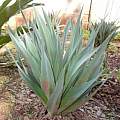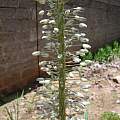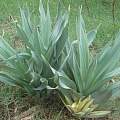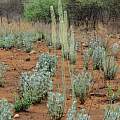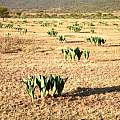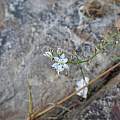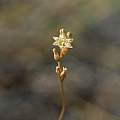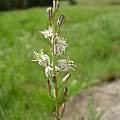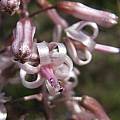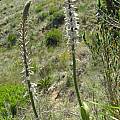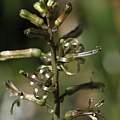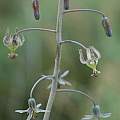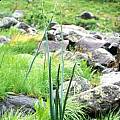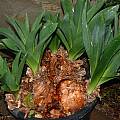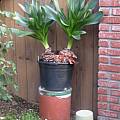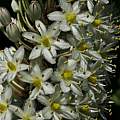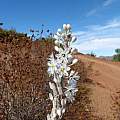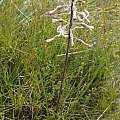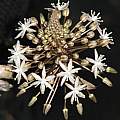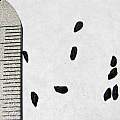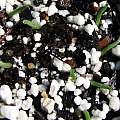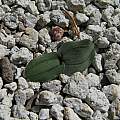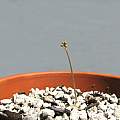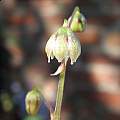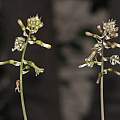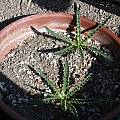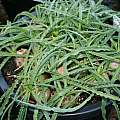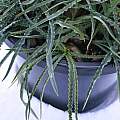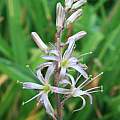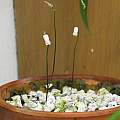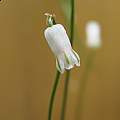Drimia Jacq. ex Willd. is a genus in the Hyacinthaceae family with white to yellowish green or brown short lived flowers. Taxonomists have now included a number of genera in this genus once separated as other genera including Fusifilum, Litanthus, Rhadamanthus, Tenicroa, Thuranthos, and Urginea.
Drimia altissima (L.f.) Ker Gawl., syn. Urginea altissima (L.f.) Baker, is a widespread species in tropical and southern Africa. Mature plants send up their tall inflorescence just before the start of the rains around November followed by sword-shaped bluish-green leaves. Seeds then ripen during the early part of the rainy season. Height range: 1-6 ft. Photos 1-5 were taken by Nicholas Wightman of plants initially from the Eastern Province, now growing in Lilayi, Zambia with photos 4 and 5 showing a variegated offset. Photo 6 was taken by Cody Howard near Octavi, Namibia.
Photos below were taken by Cameron McMaster in the Eastern Cape, South Africa.
Drimia anomala (Baker) Baker, syn. Geschollia anomala (Baker) Speta, syn. Ornithogalum anomalum Baker is distributed in the Eastern Cape and KwaZulu-Natal, South Africa. It has round green bulbs, one long slender succulent leaf produced with the flowers, and grows from 0.8 to 1 m. The greenish yellow flowers are formed in a dense raceme. Photos 1-3 were taken by Cameron McMaster in the Eastern Cape. Photos 4-5 by Alessandro Marinello.
Drimia calcarata (Baker) Stedje, syn. Urginea calcarata (Baker) Hilliard & B.L.Burtt, syn. Drimia loedolffiae Van Jaarsv., is widespread through temperate southern and southeastern South Africa, ranging from the Eastern Cape to Limpopo, Lesotho, and Swaziland, and north into east tropical Africa where it grows in seasonally damp grassland in seeps and rock flushes and on moist cliffs, sometimes on rocks along streams. The small flowers are white with green or brown keels. Leaves are erect or arching and terete. Height range: 20-30 cm. Photos from iNaturalist were taken by Rob Palmer in June at Uvongo Beach in KwaZulu-Natal and shared under a CC BY-SA license.
Drimia loedolffiae was not diagnosed against this species when it was named in 2006 and now is believed to fall within it. It is a succulent cliff dwelling Eastern Cape species found near the Kei River. Photo 1-2 was taken by the author, Ernst van Jaarsveld in the Bolo Reserve, Kei River. He also supplied photos 3-5 taken at the Kei River Mouth. Photo 6 by Alessandro Marinello shows the flower.
Drimia capensis (Burm.f.) Wijnands is found in mostly clay but also in deep red sands and limestone from southern Namaqualand to the Eastern Cape. It grows from 1 to 2 meters high. Bulbs become very large and are underground or partly exposed. The slightly undulated large leaves are dry at flowering. Flowers are white to yellowish with green keels. Photos were taken by Cameron McMaster in the Overberg.
Drimia cochlearis Mart.-Azorín, M.B.Crespo & A.P.Dold, first described in 2013, is a succulent leaved species from the Karoo, related to Drimia ciliata. This particular plant is from near Volmoed, west of Oudtshoorn. Height range: 8-23 cm. Photos from Dylan Hannon.
Drimia dregei (Baker) J.C.Manning & Goldblatt, syn. Urginea dregei Baker, syn. Fusifilum dregei (Baker) Speta, is known from the mountains and flats around Cape Town, but recorded northwards along the Cederberg to the Bokkeveld Escarpment and the Kamiesberg in Northern Cape and eastwards to the Langeberg in the Western Cape. It is found on seasonally wet or inundated flats and seeps. Flowers are inconspicuous and open only in the afternoon in mid summer (January-March) during the dry season; they are white or pale pinkish brown with a darker dorsal stripe. Height: 15-30 cm high. Photographs were taken by Christopher Whitehouse at Phillipskop Mountain Reserve near Stanford in South Africa.
Drimia echinostachya (Baker) Eggli & N.R.Crouch, syn. Urginea echinostachya Baker, is found in the midlands of the Eastern Cape and KwaZulu-Natal where it grows in stony grassland, flowering August to November, sometimes later. It has narrowly lanceolate leaves and spreading to nodding campulate cream or brownish flowers with the tepals joined below up to a quarter and with a darker dorsal stripe. Anthers and ovary are yellowish green. Height range: 4-7 ft. Photos from Cameron McMaster were taken in the Eastern Cape.
Drimia elata Jacq. ex Willd., syn. Drimia robusta Baker, is found in grassland, sandy and clay soils from Namaqualand to the Cape Peninsula, South Africa to Eastern Africa. It has purplish brown, greenish, or whitish flowers in a crowded raceme on an erect to spreading stalk. Plant height ranges from 30-100 cm. Photos from Cameron McMaster taken in the Overberg and Eastern Cape.
Drimia exuviata (Jacq.) Jessop, syn. Tenicroa exuviata (Jacq.) Speta, grows on rocky slopes and flats, often in clay or granite from Namaqualand to Grahamstown. Plants range in size from 20 cm to 1 m. It has erect firm and leathery leaves that are usually as long as the raceme. They are enclosed in a grey sheath at the base and present at flowering in spring. The fragrant flowers are white sometimes tinged pink. The first two photos were taken by Christopher Whitehouse in the Phillipskop Mountain Reserve near Stanford. The last photo is from the book Plants of the Klein Karoo courtesy of Jan and Anne Lise Schutte-Vlok.
Drimia filifolia (Poir.) J.C.Manning & Goldblatt, syn. Tenicroa filifolia (Poir.) Oberm., is found on sandy slopes and flats in a wide part of the winter rainfall area of South Africa. Plants grow from 10 to 30 cm high. This species flowers spring to summer. The first two photos were taken by Cameron McMaster in the Komsberg, part of the Roggeveld. The third and fourth photos were taken by Christopher Whitehouse in the Phillipskop Mountain Reserve near Stanford.
Drimia flagellaris T.J.Edwards, D.Styles & N.R.Crouch is a rare cliff dwelling plant endemic to the Krantzkloof Gorge system of KwaZulu-Natal, South Africa where it occurs in both exposed and shaded habitats on southern or southeastern aspects. It is evergreen with glossy green to glaucous terete leaves and white flowers with green to red-brown keels. Height: to about 5 ft. The first photo was taken by Alessandro Marinello. The next two photos from iNaturalist were taken by James Hallé in the Krantzkloof Gorge in February and shared under a CC BY-NC license.
Drimia fragrans (Jacq.) J.C.Manning & Goldblatt, syn. Tenicroa fragrans (Jacq.) Raf.), grows on sandy flats in the northwest Cape. Plants grow 30 to 80 cm high and the leaves are wiry and enclosed in a papery neck. Flowers are in an elongated raceme with elliptical tepals. Photos from iNaturalist were taken by linkie in the Biedouw Valley Youth Camp in September and shared under a CC BY-NC license.
Drimia haworthioides Baker is native to dry karroid areas from Worcester to the Eastern Cape and Karoo, South Africa. The bulb scales are large and open. These are not often exposed, but they are grown exposed for aesthetics. Each bulb scale can be removed and new plants can be grown from it. Height: 20-40 cm. This species is popular with cacti and succulent growers. Photos 1 and 2 were taken by Nhu Nguyen. Photo 3-5 are from Nick de Rothschild and were discussed on the PBS list. Photo 5 shows bulbils with the start of leaf growth, and was taken 2 weeks after the flower photos.
Drimia indica (Roxb.) Jessop, syn. Urginea indica (Roxb.) Kunth, syn. Drimia zambesiaca (Baker) J.C. Manning & Goldblatt, syn. Urginea zambesiaca Baker, ranges from the coastal parts of northern KwaZulu-Natal and northern Namibia through east and central tropical Africa to Mauritania, and India. Height range: 15-45 cm. The inflorescence appears in mid to late July in Zambia with the flowers opening in succession up the stem about a month later. Seed pods ripen and shed seeds before the start of the rainy season and only then do the leaves emerge as the rains start. Bulb scales are easily separated and used to propagate new plants as done with Lilium. (See Lilium bulbs for an example). Photos were taken by Nicholas Wightman near Lilayi, Zambia.
Known as Indian Squill, it is a bulbous, scapigerous herb renowned for its medicinal properties. It grows in dry deciduous forests and on rocky, sandy soils across several regions of the Indian subcontinent (as well as parts of Indo‐China), where its bulbs are traditionally harvested for therapeutic uses. Text and photograph by Saket Shrotri.
Drimia macrantha (Baker) Baker, known most recently as Thuranthos nocturnale R.A.Dyer, is a southern Africa species with flowers that open late in the day. Height: 10 cm. Photos were taken by Mary Sue Ittner January 2010 at Waainek in the Eastern Cape on a cool (for summer) overcast day when the flowers were open earlier. It was difficult to photograph a whole plant all in focus so the photos show various features (buds, leaves, close-ups of flowers at different stages.)
Drimia macrocentra Baker, syn. Urginea macrocentra (Baker) Jessop, is a rather strange plant known colloquially as the 'snake's head' (Slangkop) as its sinuous inflorescence is said to resemble the flared hood of a rearing cobra. The hollow, deep green cylindrical leaves are very striking when encountered in the moist grasslands of the Drakensberg foothills of KwaZulu-Natal where summer temperatures are cool. Height range: to about 3.5 ft. The first two photos from iNaturalist were taken by ansell in the Mkhomazi Wilderness area, South Africa, in November and shared under a CC BY-NC license. The last photo is a habitat photograph by Rogan Roth.
Drimia maritima (L.) Stearn, syn. Urginia maritima (L.) Baker, commonly known as the Sea Squill or the Sea Onion, is the giant among all Mediterranean geophytes. It is native to the Mediterranean coastal regions, where it grows in sand and gravel often under very harsh conditions, flowering late summer or late autumn. Height range: 1-2 ft. Broadly sword-shaped, erect, basil leaves appear in autumn, after a long spike of star-shaped, white flowers, each 1 to 1.5 cm across has developed. In spite of the specific name, this species is by far more common inland than on the sea. It grows in open spaces on shallow stony soils, with the bulbs totally above the ground. Several layers of papery tunics protect the bulbs from the sun and occasional fires don't harm them at all. Rodents don't eat the bulbs since they are poisonous. The bulbs split dichotomously from the apex rather than forming basal offsets and in time they grow to massive clumps of up to 20 heads, each one reaching up to 30 cm in diameter. It is easily grown in a dry and sunny position. Two forms are known. The one pictured in the photos below with brown reddish outer tunics is sometimes referred to as the Red Squill. This form is usually found inland and gets to be a bigger size. The other form has whitish outer tunics and is referred to as White Squill. Both forms have whitish inner tunics. Variability is also present in the flowers, which appear from the bare bulbs in late August. Some individuals have white flowers with a distinct pink midrib on the tepals and in extreme cases the flowers are all pinkish; others have totally white flowers. Leaves are dull green with a bluish waxy bloom and are a towering presence in winter, above seasonal short grasses. This species has the same growing cycle as many winter rainfall South African species like Amaryllis or Brunsvigia, but foliage resembles the foliage of Mexican agaves. The bulb of this species is used medicinally. Photos 1-2 by Angelo Porcelli and photos 3-4 from Uluwehi Knecht give a sense of scale for how large the bulbs and foliage can become (the fourth picture includes a friend's hand for scale). Photo 5 demonstrates how tall the inflorescences can grow, also from Uluwehi Knecht. Photo 6 taken by Nhu Nguyen demonstrates how a single bulb could split into a large clump when planted in the ground.
Photographs 1-2 by Bill Dijk and 3-5 by Nhu Nguyen.
The photos below were on the mystery bulbs page. Robert Hoel wrote: "In early October we were hiking in the foothills of the Atlas Mountains about an hour west of Marrakech when I realized we were in an area where these flowers were all around us." They were flowering without foliage. They were identified as this species.
Drimia media Jacq. ex Willd. is a winter-growing plant that blooms in autumn, the soft needle-shaped leaves appearing at the same time as the flowers. Height: 30-55 cm. The first photo was taken by Christopher Whitehouse in the Phillipskop Mountain Reserve near Stanford. The other photos from iNaturalist were taken by Nicola van Berkel in February near Knysna and shared under a CC BY-SA license.
Drimia minor (A.V.Duthie) Jessop is found on sandy flats in the Cape Province. It has terete erect leaves that are mostly dry at flowering and grows from 5 to 20 cm high. It has a few white to brownish small flowers and blooms from November to March. Photos by Andrew Harvie taken in the De Hoop Nature Reserve.
Drimia multifolia (G.J.Lewis) Jessop, syn. Tenicroa multifolia (G.J.Lewis) Oberm., grows to about 15 cm tall and has filiform, coiled leaves. It is found on rocks and poorly drained soils from southern Namibia, Namaqualand into the western Karoo and the southwest Cape. Photos 1-2 taken by Cameron McMaster near Bredasdorp in the Overberg. Photos 3-4 taken by Andrew Harvie in the Kamiesberg in Namaqualand.
Drimia nana (Snijman) J.C.Manning & Goldblatt, syn. Tenicroa nana Snijman, has wiry leaves enclosed in a sheath and mauve flowers with green and white patches, growing to about 4 cm. It is found in Namaqualand and flowers in summer. At least one accession described the habitat as shady mossy ledges in the Kamiesberg. Photos 1-2 were taken by Romain Amato. Photos 3-4 were taken by Dylan Hannon.
Drimia numidica (Jord. & Fourr.) J.C.Manning & Goldblatt, syn. Urginia numidica (Jord. & Fourr.) Grey, syn. Urginia maritima var numidica (Jord. & Fourr.) Maire & Weiller., grows around the Mediterranean. Height range: 30-60 cm. It is often confused with Drimia maritima. Photos from iNaturalist were taken by ejgejg and silviagu in Greece and shared under a CC BY-NC license.
Drimia physodes (Jacq.) Jessop, syn. Fusifilum physodes (Jacq.) Raf. ex Speta, is native from southwest Namibia to the Cape Province, South Africa. Plants grow to 10 cm tall. The photos below by Dylan Hannon show a plant grown from seeds from Laingsburg: Swartberg Pass, ex Silverhill. It is in some ways not unlike a miniature Drimia maritima. It is summer dormant.
Drimia platyphylla (B.Nord.) J.C.Manning & Goldblatt, syn. Rhadamanthus platyphyllus B.Nord., is a bulbous species from Namaqualand, the Richtersveld, parts of the Little Karoo, and Caledon, near the south coast. The leaves are greyish blue, with tiny, almost indistinct flowers. Height: 3-15 cm. The plant is a winter grower, dropping its leaves and then producing flowers in early summer a few weeks after the leaves have dropped. Conditions for growing Massonia should be suitable for growing this genus. I grow this plant in 75% pumice and 25% oak leaf mold. Too much water on the leaves can cause rotting. Seeds should be sown in the fall in a well drained mix (I used 50% perlite and 50% organic material). Cover the seeds with a thin layer of seedling mix. They should germinate in about 2 weeks. Seedlings tend to get a lot of water during the rainy season but do not seem to be susceptible to rotting like adult leaves. The information above and photos below were provided by Nhu Nguyen.
Photos below show: 1) tiny black seeds, 2) seedlings, 3) the leaves, 4) buds, 5) flowers, and 6) empty pods. After dormancy, I brought the plant indoors where it started to bloom and form seeds without any pollinator. I only have one plant so the plant must be self-fertile. Notice the plant's size relative to the pumice particles. The leaves are tiny, although the bulb is sizable.
Drimia salteri (Compton) J.C.Manning & Goldblatt grows on sandy or stony soils in the southwest Cape. Plants grow to 25 cm. The white to brown or maroon flowers that are open at night are crowded in a slender raceme. It flowers late spring into summer. First photo was taken by Cameron McMaster near Napier in the Overberg. Second photo by Christopher Whitehouse in the Phillipskop Mountain Reserve near Stanford.
Drimia sphaerocephala Baker is found in grassland in the Eastern Cape and KwaZulu-Natal. This species flowers before the leaves. Flowers are white, pink, or mauve with a short tube and tepals folded back. It flowers in summer. Height range: 30-60 cm.Photo from Cameron McMaster taken at Satansnek Pass.
Photos from Dylan Hannon (identification somewhat tentative) of a species grown from east of Greytown, KwaZulu-Natal. It blooms in late winter just before the leaves emerge. The bulb appears to be naturally epigeal.
Drimia undata Stearn, syn. Urginea undulata (Desf.) Steinh., is a small species native to North Africa with remarkable foliage. The plants in the photo below, purchased as bulbs from Monocot Nursery several years ago, were kept in an unheated bulb frame in northwestern Oregon. They produced their leaves in late fall and had not yet flowered at the time the photograph was added. They are kept dry during their summer dormancy. Photo by Jane McGary. Height: to about 1 m.
The photos below are of vegetative and reproductive parts of plants from Corsica, contributed by Roland and Gemma.
Drimia uniflora J.C.Manning & Goldblatt, syn. Litanthus pusillus Harv., is found in rock outcrops from Namaqualand to Zimbabwe. It is a small plant, perhaps the smallest of all bulbs growing only 2-8 cm (1-3 inches) tall. The leaves are solitary (occasionally two), linear, and are often dry at flowering. The flowers are nodding white to pale pink, often with some markings on the tepals. In the wild it blooms November to March (May-September in the northern hemisphere). The flowers seem self fertile. The seeds are not hard to germinate, but growing seedlings can be a challenge. Since the seeds are so tiny and dust-like, the seedlings are also tiny. They must be sown near the surface of a well-drained medium, but one that does not contain any sizable pieces of material. These larger pieces of the seedling mix (larger than 2 mm) can block sunlight and impede development in the tiny seedlings. Sow the seeds in spring and allow them to grow throughout the warm season. They may or may not go dormant in the first year. Grow the tiny mature bulbs in a well-drained mix, but more on the organic side. Give the bulbs plenty of water during the growing season because in habitat they occur in moist soils. Allow the bulbs to dry out during their winter dormancy.
Photographs #1 and 2 were taken by Cameron McMaster in the Eastern Cape in November and January. The third photo from Mary Sue Ittner was taken at Glen Avon. This tiny plant was growing on a rock and something had uncovered the bulbs.
The photos below were taken by Nhu Nguyen of his bulbs showing various aspects of the plant.
Drimia uranthera (R.A.Dyer) J.C. Manning & Goldblatt, syn. Rhadamanthus urantherus R.A.Dyer, is found on stony slopes in the Little Karoo. Growing up to 20 cm tall when they flower in autumn, this species has narrow and often curled leaves that appear in early winter after the flowers. Flowers are small, nodding, and golden brown with tailed anthers. Photo from the book Plants of the Klein Karoo courtesy of Jan and Anne Lise Schutte-Vlok.
For more information and to see a photo table comparing the species see the Drimia index
